It’s no surprise that the Golden State is home to a fascinating variety of black and yellow songbirds and birds of prey. If you’ve noticed an interesting black and yellow bird that you just can’t name, guess no more with our extensive identification list that will help you label a mysterious black and yellow bird in California.
Common black and yellow birds that live in or migrate through California include popular favorites like the American Goldfinch, multiple varieties of Warblers, rarer species such as the Western Meadowlark, and gorgeous birds like the Evening Grosbeak.
Check out our full list of 15 popular yellow and black birds that it’s possible to see in California.
Yellow and Black Birds in California
You also shouldn’t miss these other popular posts in this category:
- Black and White Birds in Oklahoma
- Black and White Birds in Iowa
- Popular Black and White Birds in Wisconsin
- Black and White Birds in Illinois
1. American Yellow Warbler
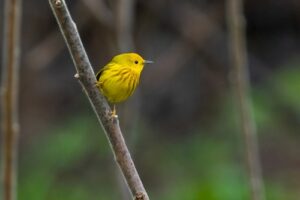
- Scientific name: Setophaga Petechia
- Diet: Insectivore
- Habitat: Swamps, gardens, bushes, and rural yards
- Lifespan: 6 years
- Size: Approximately 6 inches
- Weight: About 3 ounces
- Wingspan: Approximately 7 inches
Yellow Warblers appear in California during spring when they fly in to mate and nest over the summer. You might also notice these golden-cheeked birds hanging around through the Fall months. Look for their sleek olive-black wing feathers and signature vivid yellow chests and bellies flecked with brown speckles.
Most of the time, American Yellow Warblers hunt for insects in rural backyards, hang out in bushes near creeks, sing in fencerows by roads, and haunt local wetlands.
2. Wilson’s Warbler
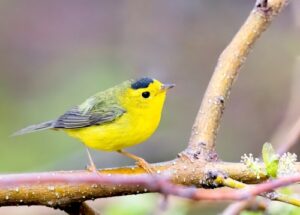
- Scientific name: Cardellina pusilla
- Diet: Mainly insectivore
- Habitat: Lakes, pastures, stream-side willow trees, or coniferous forests
- Lifespan: 5 years
- Size: 3 to 4 inches
- Weight: Up to 2 ounces
- Wingspan: About 6 inches
This distinctive warbler migrates from the south just in time to find a mate and lay eggs in the Golden State. The best time to birdwatch for them is from May to September.
They have round, lemon-yellow bodies crowned with a wide black cap for males and a lesser black cap for female birds.
Don’t feel disappointed if you don’t see these birds at your backyard feeders, since they don’t approach them, but you might be lucky enough to spot them in woods near water that has lots of bugs and insect larvae.
3. Canada Warbler
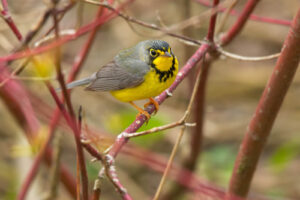
- Scientific name: Cardellina canadensis
- Diet: Primarily insectivore
- Habitat: Mixed deciduous and evergreen trees
- Lifespan: 4 or 5 years
- Size: Close to 8 inches
- Weight: 4 or 5 ounces
- Wingspan: About 8 inches
Spring also brings another unique kind of warbler to the state as flowers bloom. Check out the Canada Warbler with its gray wing feathers, yellow breast, and top identifying feature: a deep black “necklace” with dangling beads pattern around its neck. Like most avian species, the male’s necklace looks brighter and bolder than the female’s markings.
These birds are usually visible in conifer forests or woods mixed with poplar trees that are home to the Canada Warbler’s preferred insect life.
4. American Goldfinch
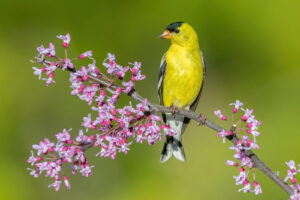
- Scientific name: Spinus tristis
- Diet: Insectivore and granivore
- Habitat: Fallow fields, urban parks, and backyard bird feeders
- Lifespan: 5 years
- Size: Approximately 4 inches
- Weight: About 2 ounces
- Wingspan: Approximately 7 inches
There are few things more American than the North American goldfinch. It’s a fitting year-round residence in the Golden State. Their buttery yellow figures crowned with a black cap and offset by white-barred wings help Goldfinches stand out particularly well against dull winter days.
While you can spot them hustling for seeds from asters, thistles, or milkweeds in empty fields in summer, come winter, just put out nyjer or sunflower seeds to watch them flock to your own backyard.
5. Yellow-Headed Blackbird
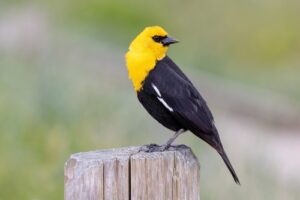
- Scientific name: Xanthocephalus xanthocephalus
- Diet: Mainly insectivore, granivore, and herbivore
- Habitat: Rivers, streams, mountainous open spaces, and marshes
- Lifespan: 9 or 10 years
- Size: 10 inches
- Weight: Up to 5 ounces
- Wingspan: 14 inches
The Yellow-Headed Blackbird is a fierce and stunning black and yellow California bird that is often spotted sitting on a fencepost or swarming with other kinds of blackbirds over farms and fields in search of insects and grain.
It is a big bird with jet-black wings and tail, white bars on the wings, and an orangish-yellow chest and head. For better identification, check out its yellow face for its distinctive black mask.
6. Common Yellowthroat
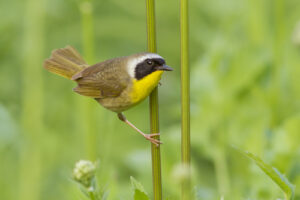
- Scientific name: Geothlypis trichas
- Diet: A mix of insectivores and herbivores
- Habitat: Wetland thickets and forests
- Lifespan: 8 years
- Size: 5 inches
- Weight: 3 ounces
- Wingspan: Approximately 7 inches
In contrast to bolder birds like the Yellow-Headed Blackbird, California also is home to olive-yellow-brown puffballs like the Common Yellowthroat. They are recognizable by their bold yellow chest patch, dark eye mask, and curving white eyebrows on male birds. Look for similar markings with a gray cap on female birds.
These lovely birds are most often seen snapping up insects along rivers and creeks that are surrounded by thick brush.
7. Yellow-Rumped Warbler
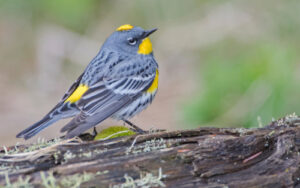
- Scientific name: Setophaga coronata
- Diet: Herbivore and insectivore
- Habitat: Evergreen trees, in yards, parks, and bushes
- Lifespan: 3 or 4 years
- Size: About 5 inches
- Weight: Approximately 1 ounce
- Wingspan: Around 8 inches
This little black and gray fellow isn’t dull at all once you spot his buttercup-yellow face, breast, and rump. While males look flashier, females also wear a faded yellow mark on their fronts.
If you spy this bird during colder months, it’s easy to mistake a male for a female Yellow-Rumped Warbler since males’ feathers get duller along with the changing nature around them.
You’re likely to find them in backyards or city parks planted with lots of evergreens such as spruce or juniper trees.
8. Cedar Waxwing
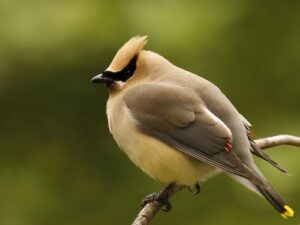
- Scientific name: Bombycilla cedrorum
- Diet: Insectivore
- Habitat: Suburban yards and orchard spaces
- Lifespan: 7 years
- Size: 5 inches
- Weight: 1 ounce
- Wingspan: 9 inches
A muted yellow and brown body probably isn’t the first thing that you’ll notice about a Cedar Waxwing. That’s because this black and yellow bird has a Lone Ranger Mask covering its eyes and red tips of color across the wings.
These birds are popular in the state from June through October when they migrate from across the Canadian border. Want to try to spot this stunning bird? Check out local orchards, fruiting shrub and berry bushes, or even plant some serviceberries in your own backyard.
9. Scott’s Oriole
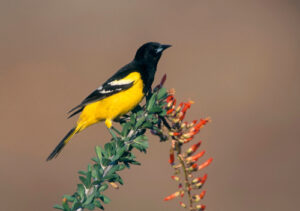
- Scientific name: Icterus parisorum
- Diet: Mainly insectivore and sometimes fructivore
- Habitat: Dry desert pinyon or other kinds of scrubby and regrown woods
- Lifespan: Up to 10 years
- Size: About 9 inches
- Weight: 2 ounces
- Wingspan: 11 or 12 inches
This active and timid songbird wears a recognizable sooty hood and feathered cape that flows over its back and chest. Look for a fat yellow belly and black wings with visible white wing bars. A female Scott’s Oriole wears a yellowish-brown hood, while her wings are darker across soft yellow body feathers.
These delightful songbirds tend to live in fast-disappearing Pinyon pines and scrubby stands of juniper trees in drier parts of the state.
Scott’s Orioles are also known for their unusual ability to consume bad-tasting Monarch butterflies. While other species give Monarchs a wide berth due to their strong taste due to a milkweed diet, Scott’s Orioles get around this problem by choosing to eat only the Monarch butterfly’s more palatable underside.
10. Western Tanager
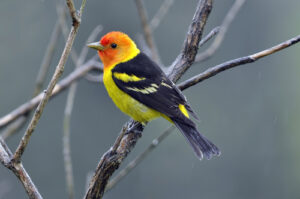
- Scientific name: Piranga ludoviciana
- Diet: Fructivore and insectivore
- Habitat: Conifers in mountainous terrain
- Lifespan: 6 years
- Size: 7 inches
- Weight: Close to 1 ounce
- Wingspan: 10 inches
A male Western Tanager is a riot of gorgeous color, from its creamy yellow body and black wings to its striking orangey-red face finished off with a black-and-yellow-barred tail. Females don’t make the black and yellow California bird list, since they are a muted mix of plain brown, dusty yellow, and greenish shades.
At the same time, it’s hard to spot these birds since they usually stick to the very top branches in open woodlands. While Western Tanagers usually don’t consume seeds, they might find their way to your yard if you put out orange slices or dried cherries.
11. Townsend’s Warbler
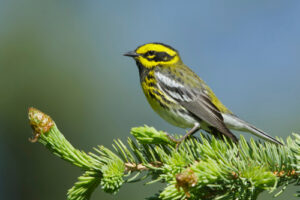
- Scientific name: Setophaga townsendi
- Diet: Mostly insectivore
- Habitat: Old-growth evergreen trees such as spruce and juniper that are covered in brushy understory
- Lifespan: 8 years
- Size: About 5 inches
- Weight: About 1 ounce
- Wingspan: 7 to 8 inches
This attractive warbler is a delight to spot in any stands of old, dense conifer woods throughout the state. That’s because it has a black and yellow body decorated with white marks and olive washes on the back. You can recognize it by the black and yellow stripes on its head.
During Fall migration times, it’s possible to watch these birds pecking away at offered mealworms, suet, or tasty peanut butter and shelled peanuts in a feeder.
12. Lesser Goldfinch
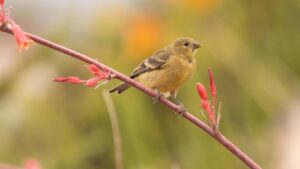
- Scientific name: Spinus psaltria
- Diet: Herbivores and some insectivores
- Habitat: Open countryside with lots of weeds and brush, gardens, and stream-side thickets
- Lifespan: 5 years
- Size: 4 inches
- Weight: Less than 1 ounce
- Wingspan: 6 to 8 inches
If you’ve spotted a midget Goldfinch, you may have found the Lesser Goldfinch. It’s a tiny finch, discovered in 1822, that belongs to the American Goldfinch family.
An adult male can have two completely different looks. In the first coloration, this species might have a lemon-yellow belly, green-toned wings and back, and a black cap. In the second morph, a male might have a completely black upper part and a vivid yellow chest and belly. In contrast, female birds and young birds have brown feathers, a yellow heads, but no black cap.
If you’re not sure about identification, check, if possible, for a short, rounded beak and a notched or forked tail. They are most often seen in open woods near open countrysides with brushy undergrowth where they source their diet of bugs and seeds.
13. Western Meadowlark
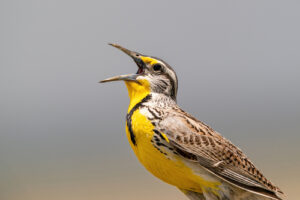
- Scientific name: Sturnella neglecta
- Diet: Sometimes insectivore and herbivore
- Habitat: Working fields, grasslands, and meadows
- Lifespan: 4 or 5 years
- Size: 10 inches
- Weight: 4 ounces
- Wingspan: 10 inches
Listen for the liquid, fluting sounds of a Western Meadowlark if you’re fortunate to catch sight of this beautiful bird. It has bold yellow underparts, a head striped with yellow and black lines, a deep black V pattern on its chest, and light gray, brown, and black flecked tail and wings.
They are sometimes seen in groups when scouting for seeds and bugs in open wetlands or fields near roads.
14. Magnolia Warbler
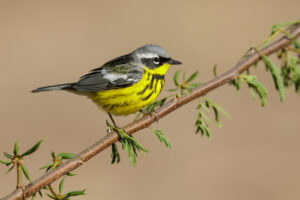
- Scientific name: Setophaga magnolia
- Diet: Insectivore
- Habitat: Mixed evergreen or deciduous trees in thick-growth forests
- Lifespan: 7 years
- Size: 4 inches
- Weight: 2 ounces
- Wingspan: 6 inches
Another delightful black and yellow California visitor is the Magnolia Warbler. Watch for its golden breast striped with black stripes that run across its sides. This bird has a gray hood marked with white and black patterns. It also wears a sooty black mask below its surprising white eyebrows.
You may see this bird on its way to breeding grounds in northern parts of the state or on its way back south in autumn to Mexican or Caribbean climes.
15. Evening Grosbeak
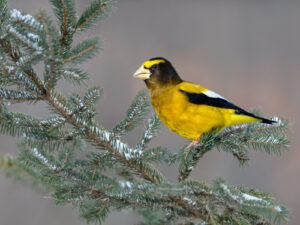
- Scientific name: Coccothraustes vespertinus
- Diet: Herbivore, fructivore, and insectivore
- Habitat: Mixed forests
- Lifespan: 12 to 15 years
- Size: 7 inches
- Weight: 3 ounces
- Wingspan: 14 inches
An Evening Grosbeak is a magical sight at any season of the year. The best time to look for them in California is in spring through autumn, although they also winter over in the state.
These breathtaking birds have round, rich yellow bodies, striking black wings and a black head. Their faces are decorated with yellow markings above the eyes and white-marked wings.
Plan to birdwatch throughout the year in Evening Grosbeaks’ favorite habitats which include agricultural land, conifer and broadleaf woods, or yards where they flock to pick up seeds or grain.
Final Thoughts
From glorious yellow warblers and meadowlarks to chirpy finches, swooping kingbirds, and stunning grosbeaks, the Golden State has a wealth of interesting black and yellow birds to keep any birdwatcher busy.
Don’t let nature keep you guessing now that you have this handy guide to get you started.

om609k
i2w3t2